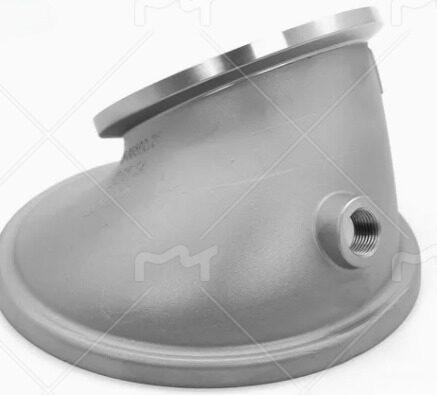In simple terms, the water glass process is the economical and practical “basic version”, while the silica sol process is the “advanced version” that pursues high precision.
Now let’s make a detailed comparison from several core dimensions:
1、Summary table of Core differences
Compare the dimensions of water glass process and silica sol process
Sodium silicate (Na₂O·mSiO₂) aqueous solution, commonly known as “water glass”, and the dispersion of nano-scale silica (SiO₂) particles in water, commonly known as “silica sol”
2、Chemical hardening method: It undergoes a chemical reaction with ammonium chloride (NH₄Cl) solution, rapidly generating silica gel that precipitates and bonds the sand grains. Physical drying: Through drying (evaporating moisture), SiO₂ particles are concentrated and lose water, forming a siloxane (-SI-O-SI -) network structure to bond the sand grains.
3、The shell-making cycle is very fast (from tens of minutes to several hours per layer), as it is a chemical reaction, and the hardening speed is fast. It is very slow (several hours to over twenty hours per layer), relying on environmental temperature and humidity for drying, and has low efficiency.
The performance strength of the shell is relatively low, its high-temperature stability is poor, and its air permeability is average. It requires “shelling” treatment. High strength, good high-temperature stability, small shrinkage and good air permeability. No need to deshell.
4、The casting accuracy is relatively low (CT7-CT9). The shell has low strength, is prone to deformation and has poor surface roughness (Ra 12.5-25μm). Extremely high (CT4-CT6). The mold shell has good stability, can replicate the fine details of the wax mold, and has a high surface finish (Ra 3.2-6.3μm).
5、Low production cost. Low material cost, high shell-making efficiency and low energy consumption. “High. Surface layer materials such as silica sol and zircon sand are expensive, the shell-making cycle is long, they occupy a large area and have relatively high energy consumption.
Detailed point-by-point explanations
1、Adhesive and hardening principle (The most fundamental difference)
Water glass process: Its bonding is a chemical process. The module that has completed the coating and sanding is immersed in the ammonium chloride hardening solution. Water glass (Na₂O·mSiO₂) rapidly reacts with ammonium chloride (NH₄Cl) to form SiO₂ gel and sodium chloride (NaCl), thereby bonding the sand grains together. This process is very fast.
Silica sol process: Its bonding is a physicochemical process. Silica sol itself is a stable colloidal solution. Through drying in an environment with controlled temperature and humidity, water evaporates, the concentration of colloidal particles increases, they approach each other and combine through hydrogen bonds and silicon-oxygen bonds to form a firm three-dimensional network structure, thereby wrapping and bonding the sand particles. This process requires time for the moisture to evaporate fully.
2、 Shell-making process and cycle
Water glass: Coating → sanding → chemical hardening (soaking in an ammonium chloride pool) → drying. It only takes a few dozen minutes to complete one layer of shell, and the entire module shell-making process may be finished within a day.
Silica sol: Coating → sanding → drying (blowing in constant temperature and humidity wind for several hours) → next layer. Since drying is a physical process, it cannot be rushed; otherwise, the strength of the shell will be insufficient. Usually, the first layer (surface layer) needs to be dried for more than 10 hours, and the subsequent back layer also requires 4 to 8 hours per layer. The entire module shell production may take 3 to 7 days.
3、 Shell treatment and dewaxing
Sodium silicate mold shell: It contains a large amount of Na₂O components (commonly known as “alkali shell”). During high-temperature baking, it will continue to react with SiO₂ in the mold shell, resulting in a decrease in the high-temperature strength of the mold shell, easy deformation, and the remaining Na₂O will undergo chemical reactions with the surface of the casting, causing defects such as “sand sticking”. Therefore, before roasting, shell removal treatment must be carried out, that is, hot water or steam is used to dissolve the Na₂O in the mold shell to transform it into a pure SiO₂ shell.
Silica sol type shell: It is inherently high-purity SiO₂, with excellent high-temperature stability. After calcination, it has a very high strength and does not require shell removal treatment.
4、Final casting quality
Sodium silicate process: Due to the relatively low strength and poor precision of the shell, the castings usually have a rough surface and large dimensional tolerances, and require more machining allowances in the subsequent process. Suitable for “rough parts”.
Silica sol process: The shell precision is extremely high, which can perfectly replicate the details (even fingerprints) of the wax mold. The surface of the casting is smooth, the dimensions are precise, and Near Net Shape casting can be achieved, greatly reducing the subsequent processing cost.
How to choose?
1、If your product is: cost-sensitive, with low requirements for surface finish and dimensional accuracy, and the material is ordinary carbon steel or stainless steel, choose the water glass process.
2、If your products are: aerospace parts, high-end medical devices, food machinery, thin-walled complex parts, or have strict requirements for surface and size, choose the silica sol process.
In addition, there is a composite process, where the surface layer (1-2 layers) uses the silica sol process to ensure surface quality, and the back layer uses the water glass or ethyl silicate process to reduce costs and improve shell-making efficiency. This is a compromise solution that takes into account both cost and quality.


